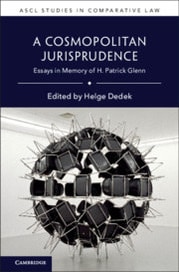Legal Monotheism and Its Discontents
January 25, 2023

[Editor’s note: this is the first of four blog posts featuring the volume “A Cosmopolitan Jurisprudence: Essays in Memory of Patrick Glenn, edited by Helge Dedek, Cambridge University Press, ASCL Studies in Comparative Law, 2022]
Patrick Glenn’s scholarship does not introduce a ‘concept of law’ or explicitly criticize the concepts of others. Yet, he trusts the findings of a long line of legal anthropologists (and a shorter one of comparative law scholars) showing that in non-Western traditions, there is no distinct line between legal and non-legal forms of normativity (Legal Traditions of the World: Sustainable Diversity in the Law, 5th edn, OUP 2014, 60–94, 98–129, 180–215, 287–315, 319–56). Yet, the method and tools Glenn relies on can be used to look into the Western legal traditions too.
In the West, political and legal theories have long been taking for granted the idea that law is the province of government and government recognized authorities, including the judiciary. They have concentrated on the processes and principles, by which the form and substance of official (State) law are determined, implemented, and enforced. By contrast, many non-official sites of legal production have always existed and still exist (outside and) inside the West. These sites produce rules that may flourish indifferent or in opposition to official law and take the settlement of disputes arising out of the application of those rules outside the ordinary circuits of adjudication. Even though the discussions about the relation between the latter rules (especially those developed by merchants) and official law is one of the most ancient debates of the law, in the last two hundred years the Western positivist attitude has been able to obscure and fence off the multifaceted dimensions of the legal experience from the spotlight of critical investigation, from law schools and from legal textbooks.
The low visibility of these unofficial legal sets in the mainstream debate, however, should not obscure thesignificant effects they can have on social order—and on the efficiency of the concerned markets and dispute-solving mechanisms. Indeed, there are many field studies conducted in different sectors of social life and business activities, showing how in those sectors unofficial law reveals itself as the controlling factor of public and private behaviors. Examples may be drawn from fields as disparate as family, religion, religion-related food, rural communities, the enforcement of commercial contracts surveyed in the local, national and global dimension, concerning e.g. the markets of cotton, diamonds, grain and feed, the online environment, the financial law (M. Bussani, Strangers in the Law: Lawyers’ Law and the Other Legal Dimensions, 40 Cardozo Law Review 3127, 3146 (2019)).
Thanks also to these field studies, in the last decades the unofficial dimension of the law has gained new scholarly traction. Law and society scholars inquire into the social structures that induce compliance, law and economics scholars examine non-State law rules and institutions that allow for efficient and desirable social results, law and psychology scholars scrutinize the motivations that ground loyalty to non-State and State laws, and all (should) profit from the long trodden path of legal anthropologists and from their findings on the cross-cultural features of social ordering, as well as from legal historians’ studies on how private and commercial law has been thriving for ages in the absence of constitutions, almighty legislatures, and State courts orderings.
The overall lesson we should learn from the above scholarship and field studies is that overlooking the sets of unofficial laws we leave behind us a piece of the real legal world that survived to our ignorance in the past and will outlive our current disregard. Unofficial law asks lawyers to ‘stop, look, and listen’ as they approach the boundary of the official legal system. What is enmeshed in unofficial laws are in fact the multi-faceted fabrics of our society, the different existing views of looking at ourselves and the others, the manifold ways of unfolding our loyalties, our identities, and our professional, social, and cultural selves. If we keep looking down on the legal offspring of all this, we miss a cognitive dimension of the law, whose loss, among other things, should urge one to define herself not as lawyer, judge, or legal scholar, but as State-law lawyer, State-law judge, State-law scholar, and nothing more. This is one of the fallouts the battle of definitions about “what is law” carries with itself – a battle Glenn wisely avoided. Searching, debating, and setting borders functional to institutional arrangements that need to keep clearly separated State law from the rest, has proved successful in the last two/three centuries and is a culturally legitimate attitude. The latter’s matrix should be disclosed, though. It is grounded on a series of (neither transcendental, nor immutable, but) historically construed notions, and the refusal to acknowledge it, acting as the ministers of a legal monotheism, reveals nothing but a path-dependent, all-Western-centric, and certainly profitable (also in view of preserving an intellectual and professional status quo) way of looking at the “law.”
Taking stock of the foregoing also explains why a pluralistic, interdisciplinary perspective on law is much needed in order to seize the ways the laws both reflect and structure human relations. Among many other things, Patrick Glenn taught us this. Such a perspective would call into question common views of official and unofficial law, connecting mainstream visions about law within the broader social contexts where laws and justice live, and unveiling the different kinds of loyalties that underlie and support the choices of official and unofficial law mechanisms and actors. To delve beyond conventional wisdom and to better understand the legal dimension through the cultural, social, and professional frameworks in which the laws operate and are embedded, would be both this perspective’s promise and challenge.
